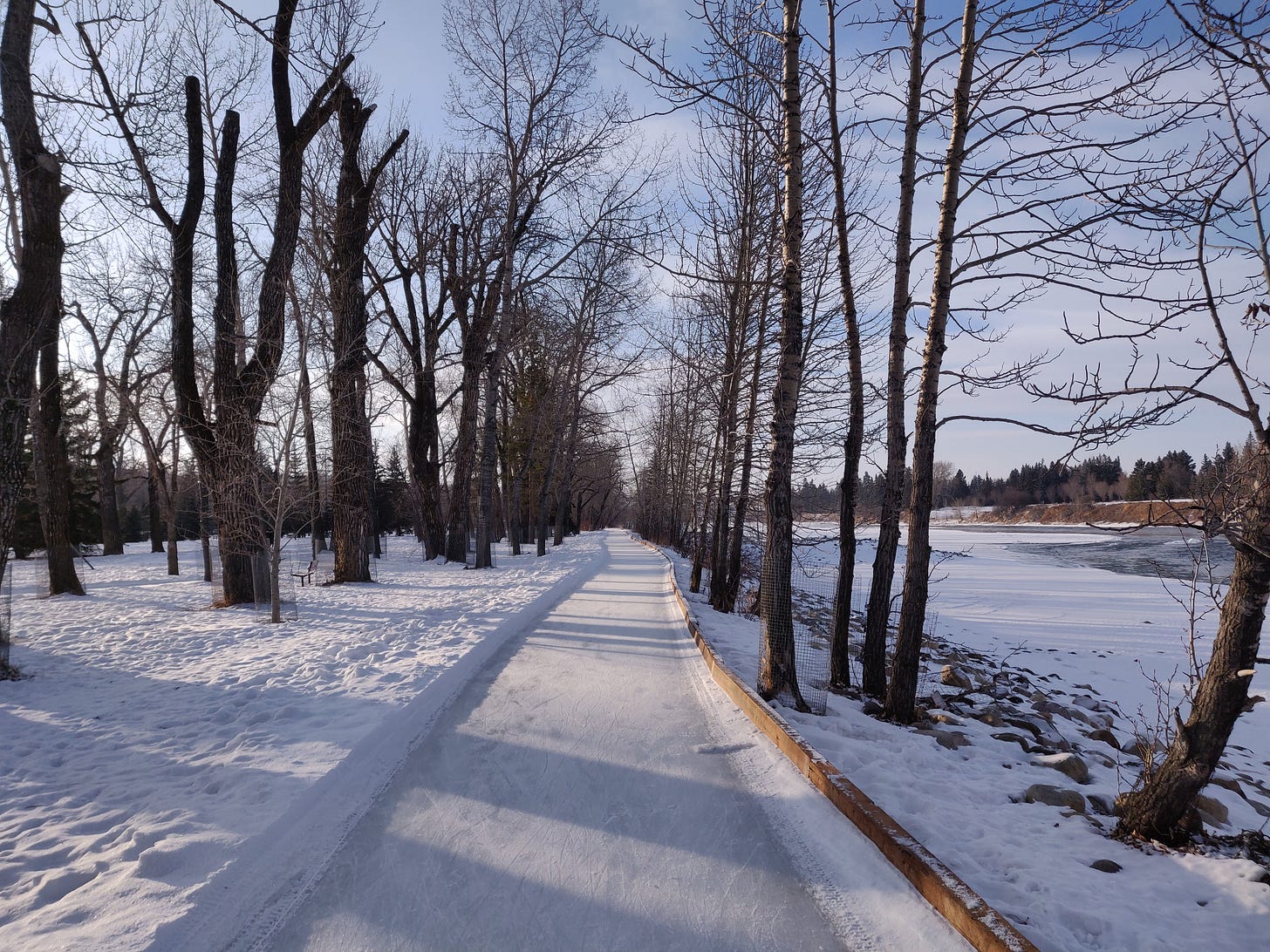3 Winter Activities to Try: Ice Biking, Hiking and Aurora Watching
Give these three activities a go before springtime arrives!
If you, like us, are getting tired of the same old walks as both winter and the pandemic drag on, it’s time for a change of scenery! Time to try something new! We’ve got three activities to try before the snow melts and spring arrives. Read on.
Ice Biking
If you’ve never heard of ice biking, don’t worry, neither had we until a couple months ago. It’s a really, really new activity. Canada’s first ice bikes were unveiled at Calgary’s Bowness Park in December. The bikes, which come in adult and child sizes, have skates instead of a front wheel. The back wheel is surrounded by skates. We recently gave the bikes a spin, and learned they’ve been popular among older Calgarians as well as people who aren’t comfortable skating.
A wide base makes balance on these bikes a non-issue — it essentially feels like you have even more sturdiness than you would with training wheels. All you need to do is pedal, steer and brake. While Cailynn figured Annalise would not enjoy the ice bike (on account of the fact Annalise doesn’t particularly like skating or regular biking on icy days), this was not the case. The ice bike was exceedingly easy to use, not tippy at all, didn’t hurt Annalise’s ankles (the way skating does) and was a fun and and cool way to see Bowness Park’s brand new ice trail. (You can also explore the ice trail on skates.) Ice bikes are only available for rent on weekends and cost $12 for a 30-minute spin or $20 for one-hour.
The scenic new one-way ice trail at Bowness Park runs alongside the Bow River.
Aurora Chasing
Aurora chasing in Big Hill Springs Provincial Park
While Aurora Borealis are visible in Alberta year-round, aurora chasing is a popular winter pastime because the long, dark nights mean more opportunities for aurora spotting.
If you’ve never tried aurora chasing, we recommend starting with the Alberta Aurora Chasers Facebook group. It’s a lively, helpful community for everyone from beginners to experts, full of tips and amazing photographs. The group also offers detailed guides on where to go to see aurora in Alberta (with clear skies, you just need to leave the city lights), understanding space weather data, and info on successfully photographing the phenomenon.
Winter Hiking
A Go Outside reader winter hiking Rummel Lake, a 12.4 km trail near Canmore.
We have to be honest. We’re not big winter hikers because we’d rather ski than walk, BUT, we have friends who love winter hiking and given how much we love summer hiking, we entirely get the appeal.
Winter hiking involves less gear and technique than cross-country or backcountry skiing, but the same stunning mountain vistas. Win-win! In terms of equipment, some winter hikers like having a pole for stability (be sure your pole has a powder basket), ice cleats or crampons and gaiters — although, depending on the trail, none of these items are absolutely essential. Make sure you dress in layers, check weather and trail conditions before you go, stay out of avalanche terrain, and pack extra layers and food.
For people new to exploring the outdoors in winter, a common mistakes we see is dressing for whatever temperature their weather app says it is. Know that the weather, especially in the mountains, can change in an instant. You absolutely must be prepared for temperatures to drop suddenly. In terms of where to go, there’s loads of online lists of good winter hikes, for all skill levels, near Calgary or Edmonton. Do research beforehand, look at maps, read trail reports and have fun!
What we’re reading this week:
For Better Health During the Pandemic, Is Two Hours Outdoors the New 10,000 Steps? asks the Wall Street Journal. “As people spend more time indoors, a mountain of scientific research says spending time in nature is critical to health and increases longevity. That means being in fresh air, under trees and away from cars and concrete—on a regular basis.”
Indigenous climbing with Cassie Ayoungman in Canadian Geographic touches on important outdoor conversations, including nature as therapy and the importance of Indigenous representation in the outdoors.
Guide who lost his vision to lead visually impaired skiers on backcountry adventure in CBC is an interesting and inspiring story about the skier behind the Braille Mountain Initiative.
Across Canada, formal nature-prescribing programs are popping up. Yesterday, Ontario started allowing doctors to write prescriptions for nature. “A strong body of research shows that those who spend as little as 20 to 30 minutes a day outdoors report better health outcomes, including regulation of blood pressure, diabetes, mental health, and boosted immune response. Other benefits are improved concentration, sleep and sense of well-being,” says the Toronto Star.
In case you missed it:
We were invited on CBC TV last week to talk about our recent issue detailing tips for snacking outside during winter! You can watch or read what we had to say here, including footage from a -25C ski during the recent cold snap.
Go Outside is a Substack newsletter about nature. Subscribe today and you’ll receive free advice, stories, trip reports and outdoorsy goodness in your inbox every Tuesday morning. If you like our writing, please share this newsletter with your friends! You can read all our previous issues here.







